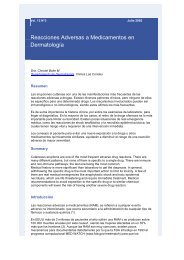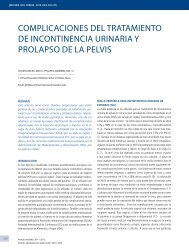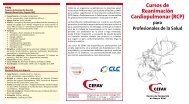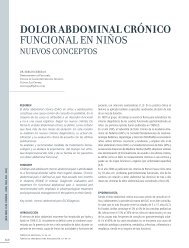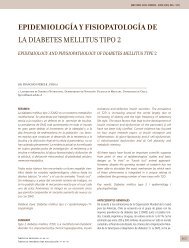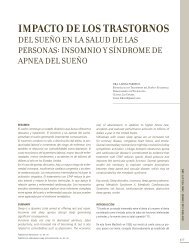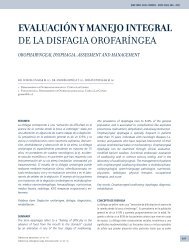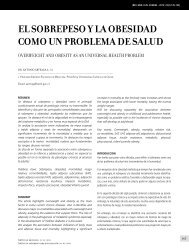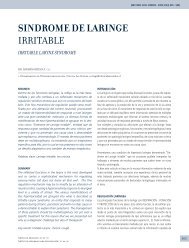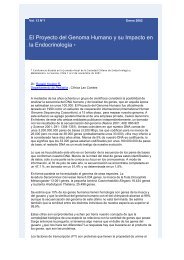ClÃnica Las Condes / vol. 24 n0 1 / enero 2013
ClÃnica Las Condes / vol. 24 n0 1 / enero 2013
ClÃnica Las Condes / vol. 24 n0 1 / enero 2013
You also want an ePaper? Increase the reach of your titles
YUMPU automatically turns print PDFs into web optimized ePapers that Google loves.
[REV. MED. CLIN. CONDES - <strong>2013</strong>; <strong>24</strong>(1) 149-156]<strong>Las</strong> entidades con hipoperfusión constante son la depresión caracterizadapor disminución de función a nivel de la corteza órbito-frontalbilateral (área 11 de Brodmann) y del cingulado anterior (área <strong>24</strong> y 25de Brodmann) (región subgenual del cingulado anterior). También seobserva en esta entidad aumento de perfusión talámica.En las esquizofrenia las alteraciones de hipoperfusión son fundamentalmentetemporales y lateralizada a la izquierda en el área 21 y 22 deBrodmann y a nivel del cingulado anterior área <strong>24</strong> y 25 de Brodmann,en el cingulado intermedio área 23 de Brodmann y en el área 30 deBrodmann en el cingulado posterior. También se observa disminución deperfusión en le hipocampo y en el núcleo caudado.Los hallazgos en exposición a drogas son multifocales de distribucióndesorganizada y la enfermedad de Alzheimer’s se manifiesta por disminuciónde función parietal posterior área 7, temporal lateral área 21y 22 y el área 30 de Brodmann el cingulado posterior, igualmente seobserva disminución de función temporal mesial, del hipocampo y alteracionestalámicas y del núcleo caudado.<strong>Las</strong> características descritas en distintos procesos psiquiátricos permitenuna ayuda efectiva en el diagnóstico diferencial clínico psiquiátrico yasí convierten al NeuroSpect en un elemento positivo de ayuda al manejode adultos y niños que muchas veces se presentan con procesosde comorbilidad que complican la evaluación en el manejo de estánentidades. NeuroSpect se convierte así también en una herramienta dealta sensibilidad y especificidad para el control terapéutico de estas entidadesclínicas.REFERENCIAS BIBLIOGRáFICAS1. Mena, Francisco J.; Mena, Ismael; Ducci, Hector. et al. Tc99m-HMPAONeuro--SPECT Assessment of Ischemic Penumbra in Acute Brain Infarct:Control of Intra-arterial Thrombolysis Treatment. Alasbimn Journal7(26): October 2004 http://www2.alasbimnjournal.cl/alasbimn/CDA/sec_b/0,1206,SCID%253D12208,00.html.2. Mena, Ismael. Contribución del NeuroSPECT a la evaluacion del AVEisquémico : Penumbra isquemica. Rev. Med. Clin. <strong>Condes</strong>. 2009, 20 (3) 276-281.3. Lesser I, Mena I, Boone K, Miller B, Mehringer CMM, Wohl M Reduction ofcerebral blood flow in older depressed patients. Archives of General Psychiatry1994;51:677-686.4. Prado C. M.D. and Ismael Mena M.D. Basal and frontal activationneuroSPECT demonstrates functional brain changes in major depression.AlasbimnJournal1(3): April 1999. “http:/www.alasbimnjournal.cl/revistas/3/pradoia.htm”.5. Mena I. Prado C., Correa M. “Comparative Functional Study of TwoPsychiatric Pathologies by means of BrainSPECT Tc99 HMPAO. Major Depressionand Borderline Personality Disorder. Alasbimn Journal 3(11): April 2001.6. Mena, I., Correa R., Nader A. y Boehme V.. Bipolar affective disorders:Assessment of functional brain changes by means of Tc99m HMPAO NeuroSPECT.Alasbimn Journal 6(23): January 2004. http://www2.alasbimnjournal.cl/alasbimn/CDA/sec_b/0,1206,SCID%253D7485,00.html .7. Mena, Ismael, Correa, Rodrigo y Armando Nader. Alteraciones neurofuncionalesen trastornos del ánimo que cursan con conductas auto-mutilatorias:estudio de perfusión regional cerebral a partir de la técnica de Neuro-SPECT Tc99-HMPAO. Alasbimn Journal 9(36): April 2007. Article N° AJ36-2. http://www2.alasbimnjournal.cl/alasbimn/CDA/sec_b/0,1206,SCID%253D19905,00.html.8. Rubin RT, Villanueva-Meyer J, Ananth J, Trajmar PG, Mena I Regional 133Xecerebral blood flow and cerebral 99mTc-HMPAO uptake in unmedicatedpatients with obsessive compulsive disorder and matched normal controlsubjects: Determination by high-resolution single-photon emission computedtomography. Arch Gen Psychiatry; 49:695-702, 1992.9. Rubin RT, Ananth J, Villanueva-Meyer J, Trajmar PG, Mena I Regional xenon133 cerebral blood flow and cerebral technetium 99m HMPAO uptake inpatients with obsessive compulsive disorder before and during treatment. BiolPsychiatry 1995;38:429-437.10. Mena I, Miller BL, Giombetti R, Villanueva-Meyer J, Djenderedjian AHNeuropsychiatric effects of cocaine: SPECT measurements. J of AddictiveDiseases 11(4):47-57, 199211. Strickland TL, Mena I, Villanueva-Meyer J, Miller B, Cummings J, MehringerCMM, Satz P, Myers H Cerebral perfusion and neuropsychological consequences ofchronic cocaine use. J Neuropsychiatry and Clin Neurosciences 5:419-427, 1993.12. Heuser G., Mena I. Neurospect in neurotoxic chemical exposuredemosnstration of long-term functional abnormalities. Toxicology and IndustriaHealth, Vol. 14, Nº 6, 1998; pp. 813-82713. Villanueva-Meyer J., Mena I., Miller B., Boone K., Lesser I., Cerebral bloodflow during a mental activation task: responses in normal subjects and in earlyAlzheimer disease patients. Alasbimn Journal1 (3):“http:/www.alasbimnjournal.cl/revistas/3/villanuevaa.htm”.14. Shankle, William R.; Mena, Ismael; Hara. et al. NeuroSPECT DemonstratesIncreased Cortical Function in Alzheimer’s Disease Patients For At Least TwoYears After Omental Transposition Neurosurgery. Junko Alasbimn Journal 8(31):January 2006. Article N° AJ31-1. http://www2.alasbimnjournal.cl/alasbimn/CDA/sec_b/0,1206,SCID%253D15971,00.html.15. Defigueiredo,RuiJ.P .; RodmanShankle,W. ; Maccato,Andrea ; Dick,MalcolmB.; Mundkur,Prashanth ; Mena,Ismael et al. Neural-Network-Based Classificationof Cognitively Normal, Demented, Alzheimer Disease and Vascular Dementiafrom Single Photon Emission with Computed Tomography Image Data fromBrain Proceedings of the National Academy of Sciences of the United States ofAmerica, Volume 92, Issue 12, pp. 5530-5534.El autor declara no tener conflictos de interés, con relacióna este artículo.156



